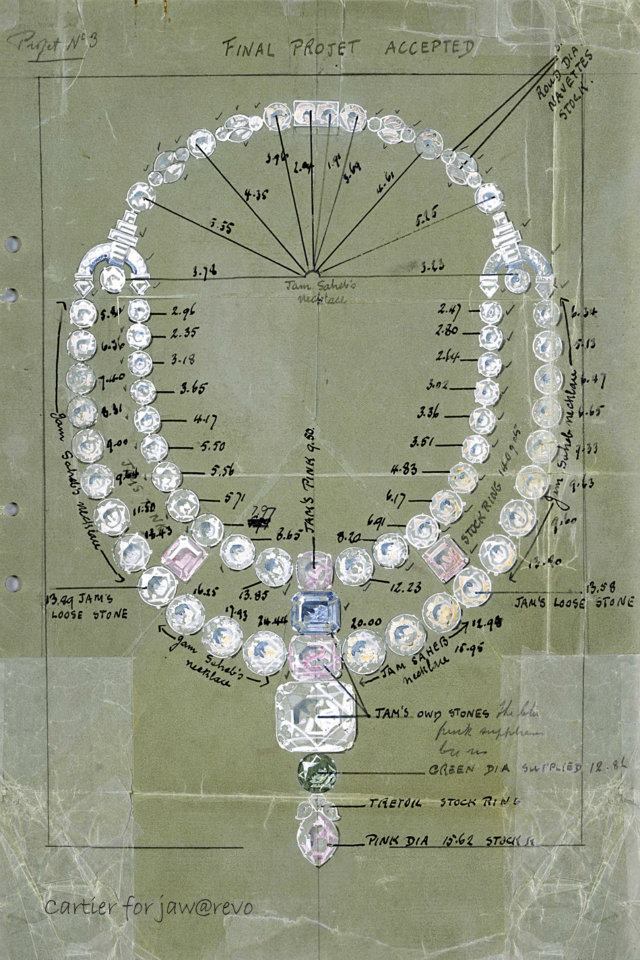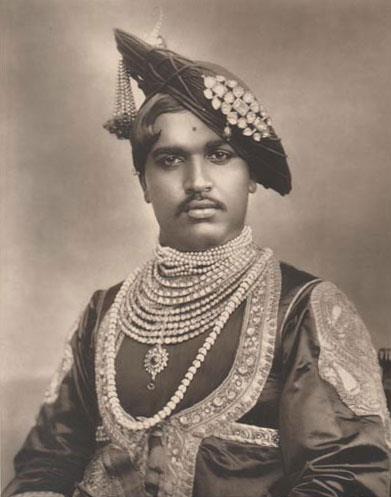MAGNIFICENT KING MAHARAJAS OF INDIA
Maharajas! The word maharaja, literally ‘great king’, conjures up a vision of splendor and magnificence. These princely rulers of India played a role within a social and historical context and were patrons of the arts, both in India and Europe. That resulted in magnificent objects symbolic of royal status, power and identity.
According to an account by Alain Boucheron on his family business in the book “The Master Jewelers” that was cited in the Times:
"The flamboyant Maharajah... arrived at Boucheron's in 1927 accompanied by a retinue of 40 servants all wearing pink turbans, his 20 favorite dancing girls and, most important of all, six caskets filled with 7571 diamonds, 1432 emeralds, sapphires, rubies and pearls of incomparable beauty.”
Here's a look at the opulent world of the maharajas and their extraordinarily rich culture thought their jewels.
I have tried my best to attribute images to their creators and original sources. Please contact me if you know the source of images that are not attributed.

Maharajah of Patiala, Yadavindra Singh. Patiala Necklace.

Maharajah of Patiala, Yadavindra Singh. Patiala Necklace. Weighing almost a 1000 carats, Patiala necklace was made for the Maharaja in 1928 by Cartier, the bib-like Art Deco necklace featured five rows of diamond-encrusted platinum chains and over-sized gems. It included as its centerpiece the famous De Beers diamond, a cushion-cut pale yellow diamond weighing 234.69 carats.

Jacques Cartier with Indian gemstone merchants, 1911, Cartier Archives. Since his first trip to India, in 1911, Jacques Cartier (1884-1942) had become familiar with the extravagant tastes of the maharajas. Fabulously rich and passionate about precious stones, the Indian princes stopped at nothing to satisfy their perpetual appetite for jewels.

Drawing of the ceremonial necklace for the Maharajah of Nawanagar, 1931, London Cartier Archives. Jacques Cartier presented the Maharaja with a dazzling project. Sadly, the Maharaja of Nawanagar had little time to wear the “finest cascade of coloured diamonds in the World”. He died in 1933, two years after the necklace was delivered.

The famous Baroda Diamond Necklace. This magnificent ceremonial necklace with diamonds and emeralds was worn by the Maharaja (King) of Baroda, India in the 1860s. It was said to have been broken up in the 1940s to provide stones for anklets for the new Maharani (Queen) of Baroda, Sita Devi.

From The Treasury of Baroda - a magnificent three-tired diamond necklace, shown here worn by the Maharani of Baroda, Sita Devi in 1948.
Khande Roe, Gaekwar of Baroda, had this necklace made to display two important diamonds - The 128.48-carat Star of the South (fancy light pinkish-brown) and the 78.5-carat English Dresden below it. Necklace photo: circa 1880.
Khande Roe, Gaekwar of Baroda, had this necklace made to display two important diamonds - The 128.48-carat Star of the South (fancy light pinkish-brown) and the 78.5-carat English Dresden below it. Necklace photo: circa 1880.

This breathtaking 61.50-carat whiskey-colored diamond, ‘The Eye of the Tiger’, was mounted by Cartier in a turban aigrette for the Maharaja of Nawanagar (India) in 1934.

One of the highlights for me at 'Diamonds: A Jubilee Celebration' exhibition was this incredible 2000-carat, King Edward VII's diamond encrusted sword.Set with more than 700 white and yellow diamonds, the sword was presented to King Edward VII by the Maharajah of Jaipur, Sawai Sir Madho Singh Bahadur, to mark the king's coronation in 1902. Made from steel and gold, enamelled in blue, green and red, the diamonds are set in a design of lotus flowers and leaves. Photo:© PA

Maharaja Bhupendra Singh of Patiala. 1911. Wears an aigrette or Sarpech by Cartier and various other turban ornaments. While the front of aigrette is set with diamonds, rubies and emeralds, the back shows the intricacy of craftsmanship with foliate motifs of red, green and blue enamel. He also wears a necklace of fourteen strands of natural pearls.

Bejeweled Maharaja of Mysore. © V&A Images/Victoria and Albert Museum, London.

Maharaja Sawai Jai Singh Bahadur of Alwar, born 1882. Besides his traditional Indian ornaments, he wears the star insignia of the Indian orders granted to him by the British (Raj), then considered a part of the royal regalia.

Maharaja Sayaiji-Roa, Gaekwar, Baroda. 1902. Wearing his famous seven row diamond necklace and other diamond ornaments. In the late 19th and early 20th centuries, virtually every Indian Maharaja commissioned state photographs of themselves wearing their most important jewelry as a symbol of their power and position.

A cross cultural exchange. Miniature painting. National Gallery of Modern Art, New Delhi, India. 1902. Interpreted by an Indian artist (unknown), King Edward VII and Queen Alexandra, depicted as the King-Emperor and Queen-Empress of India.

Raja Savant Singh and Bani Thani. 1780. Courtesy Spink and Sons Ltd. London. Kishengarh miniature painting, characterized by exaggerated profiles. Both with traditional Mughal-Rajput-style ornaments consisting of pearls, emeralds and rubies.

Diamonds and emeralds set in platinum. Aigrette (also known as Sarpech - Turban ornament). Private collection. 1930

The state durbar decorated elephant, with attendants of the Maharaja of Mysore. Royal India.

End of 19th century rendering by Chaumet staff designer, of a proposed ensemble of ornaments for the uniform of a Maharaja. Rendering shows the use of diamonds, emeralds and pearls. Courtesy Chaumet.

1925. Rendering by Charles Jacqueau of Cartier for a headdress ornament for a turban, a project suggested by Maharaja of Kapurthala. Courtesy Cartier.

Jade case, 1700-1800. Jade, rubies, emeralds, diamonds, steel. © V&A Images/Victoria and Albert Museum, London.

Maharaja of Mudhol, Gangadhar Rao (1915-1974).

The superb clarity and color of emerald ranks it among the world's finest Colombian emeralds. It was once the centerpiece of an emerald and diamond necklace belonging to the Maharani of the former state of Baroda , India. It originally weighed 38.4 carats, but was recut and set in a ring designed by Harry Winston, where it is surrounded by 60 pear-shaped diamonds totaling 15 carats. Photo: Smithsonian

Maharaja Dilip Singh of Lahore. 1852. Portrait by George Beechy. Shown here at age fifteen. Amongst many other jewels, he is wearing a diamond Sarpech (Indian turban ornament) or aigrette with three plumes and a centrally placed emerald.

Van Cleef & Arpels, Paris, 1949–50. The "Baroda Set" ordered by the Maharani of Baroda, “The Indian Wallis Simpson”, wife of the Maharaja of Baroda. This impressive suite of jewellery was designed by Jacques Arpels for Sita Devi, the second wife of Maharaja Pratapsinh Gaekwad of Baroda. It consists of 13 pear-shaped Colombian emeralds – 154 carats in total – suspended from diamonds set in the shape of a lotus flower. All the gems were all supplied by the Maharani and belonged to the Baroda Crown Jewels.

Khande Roe, Gaekwar of Baroda, had this necklace made to display both the 128.48-carat "Star of the South" and the 78.5-carat "English Dresden" below it. Photo circa 1880.

Turban ornament- gold, diamonds, rubies, emeralds, sapphire, pearl. Image: V&A

The Maharaja of Darbhanga. Royal India.

The Maharaja of Alwar. (1882-1937). Royal India.

Renowned for its impressive size, intense color and sharp star, the Star of Asia, which weighs 330 carats, is one of the world’s finest star sapphires. It originated from Burma and is said to have belonged to India’s Maharajah of Jodhpur. Photo by Chip Clark

Emerald and diamond necklace, containing 17 rectangular emeralds, 277 carats. The emerald in the pendant weighed 70 carats and was reputed to have come from the collection of a former Sultan of Turkey. Jacques Cartier set it in a Art deco piece for the Maharaja of Nawanagar.

Maharajah of Nawanagar wearing the emerald and diamond necklace created by Cartier in 1926, Cartier Archives.

The Maharana of Udaipur. Royal India.

Maharaja Bhupendra Singh of Patiala. Image: © National Portrait Gallery, London

The Gaekwar of Baroda. Diamond necklace made to display both the 128.48-carat "Star of the South" and the 78.5-carat "English Dresden" below it.

The Maharaja of Jammu & Kashmir. Royal India.

Emerald necklace & pendant that belonged to Maharani Prem Kumari, wife of the Maharaja of Kapurthala. 1910

Sprays of flowers turban jewel. Once belonged to the Maharaja of Jaipur. The aigrette is set with rubies, emeralds and pale beryls on one side, and the same stones with the addition of diamonds on the other. The stem and the sides of the jewel are enamelled in translucent green.

Prince, The Gaekwar of Baroda. Princely India.
Diamond necklace made to display both the 128.48-carat "Star of the South" and the 78.5-carat "English Dresden" below it. Royal India.
Diamond necklace made to display both the 128.48-carat "Star of the South" and the 78.5-carat "English Dresden" below it. Royal India.


.jpg)

Post a Comment